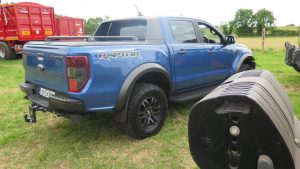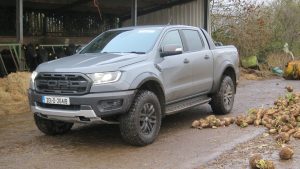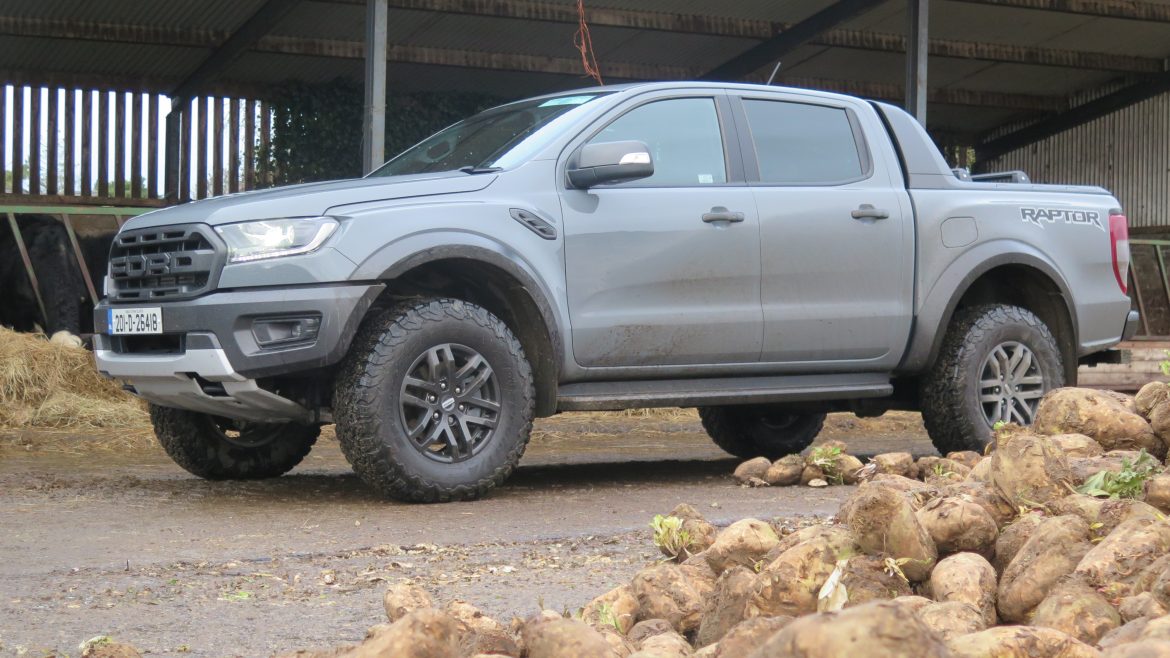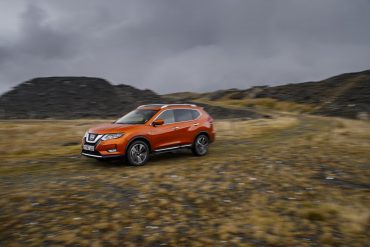Michael Moroney allowed himself a repeat indulgence at the end of 2020 by taking Ford’s new Ranger Raptor high performance 4×4 pick-up for additional serious off-road tests. Here he reports on his drive through the midlands and across some challenging wet December fields where the Raptor can show its true sand driving abilities as well as some practical farm work.
This was my second opportunity to take the powerful Ford Ranger Raptor for a test drive and what a contrast between the wet December and the summer months of 2019. We must start by saying that this is no ordinary 4×4 pickup, but one designed to test driving skills in the most severe conditions, be they wet or dry.
The Ford Ranger Raptor comes with high off-road expectations. These include tough field conditions and the ultimate test that of fast off-road driving across muddy water soaked fields and sandy beaches. And December provided the former as torrential rains battered the country but not the off-road ability of the Ranger Raptor.
That’s because this Ranger Raptor version has what Ford calls a new terrain management system that links suspension settings with engine and gearbox ones. The new system option includes what is called the Baja setting for high speed off-road performance similar what US drivers need in the now famous Baja Desert Rally.
Across the wet fields, the Ranger’s ability to keep moving with a combination of engine torque and tyre floatation, meant that we could test its ability in confidence. The challenge was not to get stuck in waterlogged fields as the downpours continued.
The BF Goodrich tyres gripped the field surface without ripping it and digging in, this time demanding gentle driving compared with the higher speed momentum that I needed when driving on the summer sands. It’s a balance of floatation and momentum as the conditions will dictate.
Ford aims to retain its dominant position on the European 4×4 pick-up market by offering the Raptor version to those drivers who want all of the practical stuff with a bit more off-road ability for some weekend fun driving that provides a greater skill challenge. And with the Raptor Ford has shown that this 4×4 pick-up delivers performance.
What impresses about this Ranger Raptor is it is fitted with a new Ford 2.0 litre twin turbo-diesel engine, similar to the engine that’s fitted in Ford’s Edge large SUV. This engine will soon replace both the 2.2 litre and 3.2 litre versions with claims of a 9% improvement in fuel economy.

In the Raptor this new engine power is rated at 213bhp, and generates a massive 500Nm of torque. And it does so with ease, especially when mated to Ford’s new 8 speed automatic gearbox that’s not always the smoothest in action.
What makes the Raptor very different is the special suspension that gives longer travel and more stability in difficult driving conditions. The front suspension includes Fox long travel shocks while the rear has a new Watts link suspension. The rear brakes replace drums with ventilated discs and you will find them in the standard Ranger.
Ford has also replaced the traditional leaf system with a coil system on the Ranger Raptor that gives more comfort and off-road stability. The higher vehicle stance gives more movement, while it was still one of the most comfortable 4×4 pick-ups that I’ve driven. The one compromise has been to the towing ability as it has dropped from 3.2 tonnes to 2.5 tonnes for the Raptor models.
This Raptor version also features a wider wheelbase than the standard Ranger in an effort to add to its stability. The safety package includes Pre-Collision Assist with Pedestrian Detection and Intelligent Speed Limiter technologies as standard. And there’s a reversing camera for ease of parking when you come home from the thrills of off-road performance driving.
This Ranger Raptor is at the top of the price list for the range, so you need to be well motivated in terms of image and desire for off-road driving to justify the extra expense. It will do more than the standard Ranger when it comes to off-road ability, but I expect with a good set of tyres and with the right hands on the steering wheel, the standard Ranger can probably come close in terms of general off-road driving.
On a more practical level, the Ranger Raptor is slightly less economical than the standard model. I found that even though the automatic gearbox gave 120km/hr motorway speed performance at just 1750rpm on the engine, like a thoroughbred horse, it was always keen to race that bit faster.
You won’t buy the Ranger Raptor for its economy. I returned a range figure of over 550km from a full tank. To be fair that included some light trailer work and a range of off-road driving that always takes a toll in terms of economy. Ford reckon that ‘normal’ driving should extend that range of 30%, but given the engine performance, it can be a wild horse to control.

The price for the Ford Ranger Raptor is cheap, starting at €62,010 incl. VAT, that’s more than €26,000 more than the entry level model. It is still a commercial vehicle with a tow-bar as standard and comes with all of the taxation benefits along with its serious go-off road ability. So there are some serious upsides in addition to the fun side of driving a Raptor and that’s why some off-road enthusiasts will join the Raptor clan and they will be well satisfied.

| Ford Ranger Raptor – specifications | |
| Engine | 2.0 litre |
| Engine power | 213bhp |
| Engine Torque | 500Nm |
| 0 – 100km/hr | 10.5 seconds |
| Economy | 11.2km/l (8.9/100km or 32mpg) |
| Fuel Tank Capacity | 80 litres |
| CO2 emissions | 233g/km |
| Range | 880km |
| Road Tax Band | Commercial €333 |
| Main Service | 15,000km/12 months |
| Euro NCAP Rating | 5 Star (2015) |
| Towing rating | 2500kgs |
| Kerb Weight | 2510kg |
| Warranty | 3 years |
| Entry Price | €62,010 |





